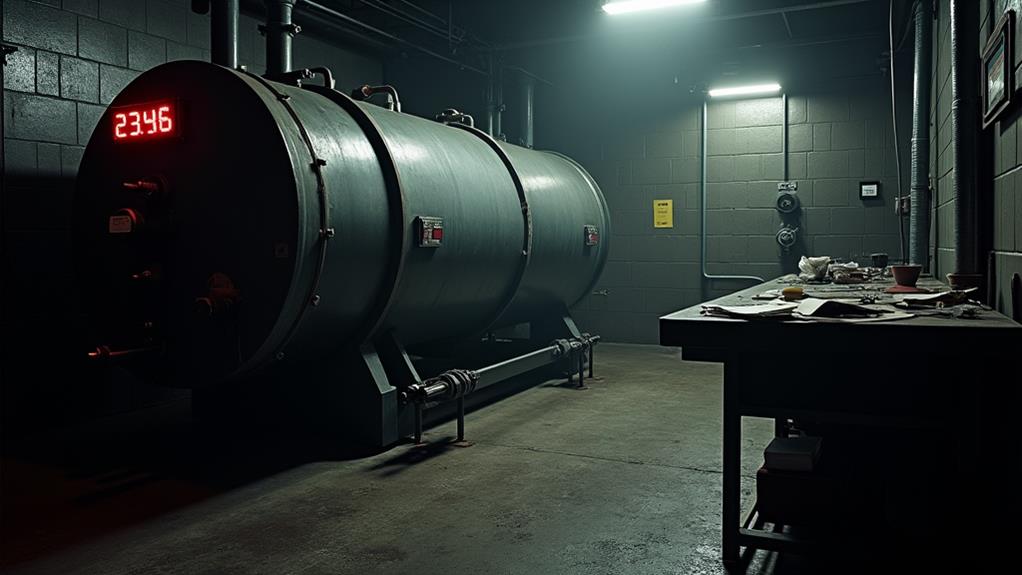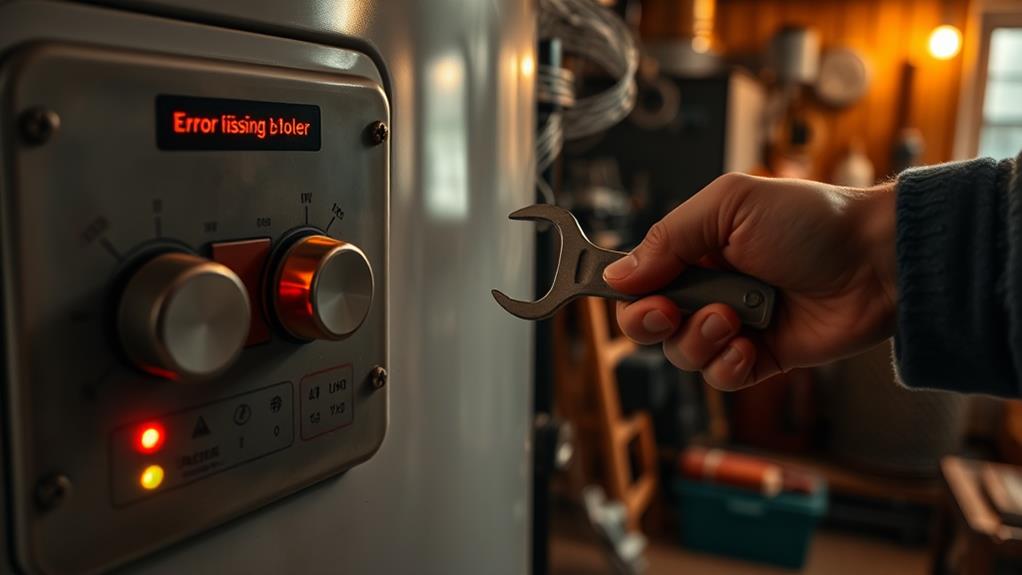You’re encountering the F.28 error code on your boiler, signaling an ignition failure that disrupts normal functionality. This often results from issues like gas supply disruptions, faulty gas valves, or ignition electrode malfunctions. Start by checking if the gas valve is fully open and the supply pressure meets specifications. Inspect the ignition electrodes for damage and guarantee they maintain the correct gap. Listen for unusual sounds that might suggest malfunctions. If basic checks don’t resolve the issue, professional intervention is essential. By addressing these aspects, you can understand the intricacies of your boiler’s ignition system and restore its operation.
Key insights
- The F.28 error code signifies an ignition failure impacting the boiler’s functionality.
- Common causes include gas supply issues, faulty gas valves, and ignition electrode malfunctions.
- Inspect ignition components, gas supply, and reset the boiler to troubleshoot the error.
- If the error persists, contact a professional to assess potential faulty sensors or blocked flues.
- Regular maintenance and timely inspections can prevent future occurrences of the F.28 error.
Understanding the F.28 Error Code
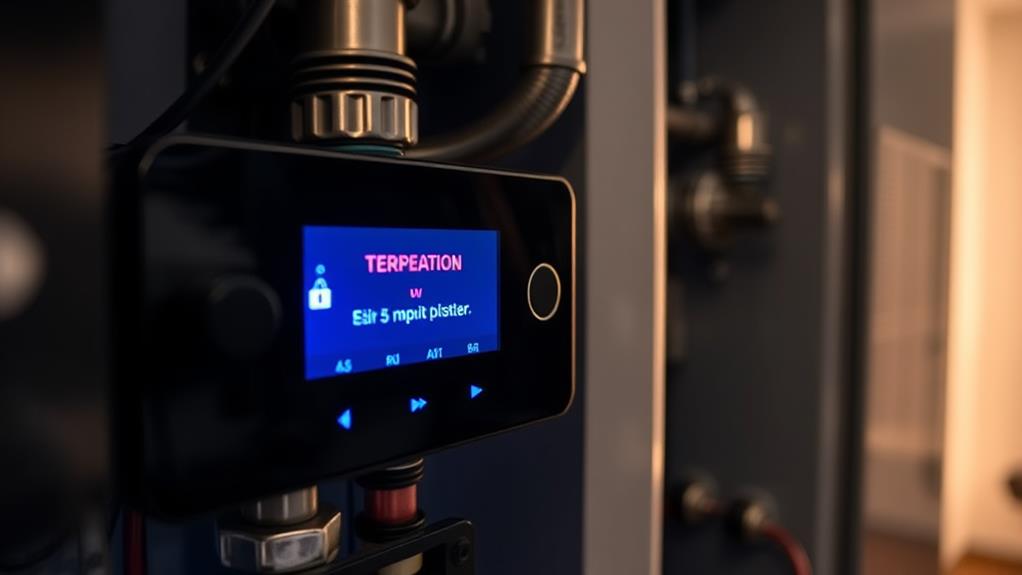
To effectively troubleshoot the F.28 error code on your boiler, it’s important to understand its fundamental implications. This error code typically signifies an ignition failure, which directly impacts the boiler functionality. When your boiler displays the F.28 error, it indicates that the ignition process has been interrupted or unsuccessful, preventing the boiler from operating correctly.
Understanding this code is significant for determining whether the issue is something you can address yourself or if professional intervention is required. It’s important to remember that self-servicing is generally not recommended due to the specific expertise required in handling such delicate machinery. In addition, regular servicing by qualified engineers can help guarantee that your boiler operates safely and efficiently, potentially preventing error codes like F.28 from arising in the first place.
Error code interpretation is a fundamental skill in maintaining your boiler’s efficiency and longevity. The F.28 code is fundamentally a signal that something within the ignition system isn’t working as it should. It could be related to various components such as the gas supply, ignition electrode, or even the control board. Each of these elements plays a significant role in the boiler functionality, and a failure in any part can trigger the F.28 code.
Common Causes of F.28 Error
Several key factors can lead to the F.28 error code on your boiler, each requiring careful examination. One common cause is gas supply issues. The boiler relies on a consistent gas flow to function effectively. If there’s an interruption or a reduction in gas pressure, the boiler’s functionality can be compromised, triggering the F.28 error. This is one of the reasons why hiring qualified installers is vital as they guarantee the best setup avoiding such errors. Check the gas supply line for any blockages or leaks as part of your error diagnostics.
Another potential cause is a faulty gas valve. The gas valve controls the flow of gas into the combustion chamber, and if it’s malfunctioning, the boiler might not receive the necessary fuel to ignite properly. In line with the need for regular maintenance, as mentioned in the KNOWLEDGE, inspecting the valve for any signs of wear or damage is important.
Electronic ignition issues can also result in this error code. If the ignition system isn’t operating correctly, it won’t ignite the gas, halting the boiler’s operation. While the ignition system itself will be discussed in detail later, make sure that all related components are in working order.
Identifying Ignition Issues
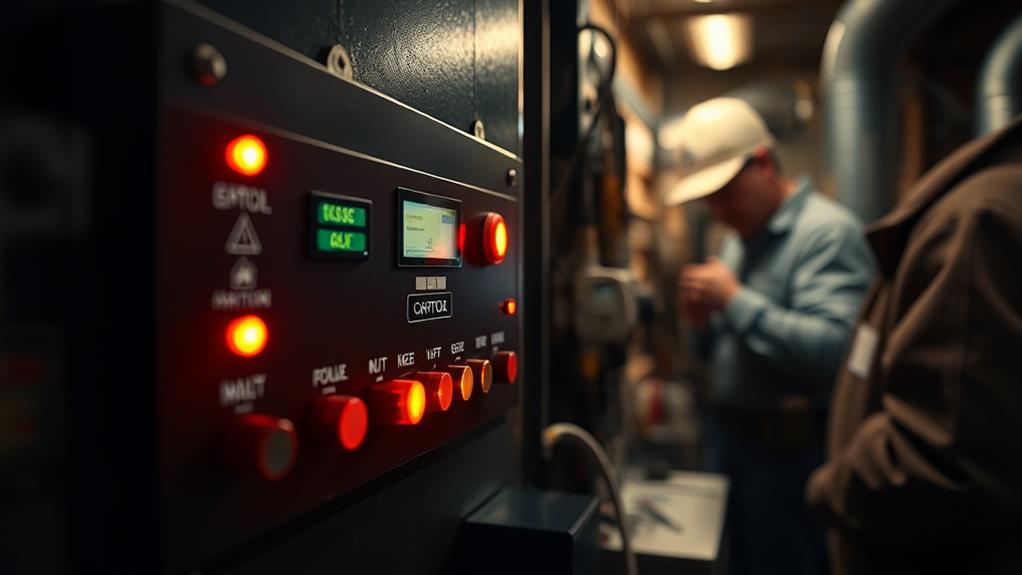
Diagnosing ignition issues in a boiler requires a systematic approach to verify all components are functioning seamlessly. This process is similar to the initial consultation involved in installing a heating system, where the system’s condition and needs are thoroughly assessed. Start by examining the ignition sequence, a critical process where each step must operate correctly for successful ignition. First, verify the boiler initiates the start sequence without interruption. Listen for any unusual sounds like clicking, which might indicate a malfunctioning ignition electrode or spark generator.
Next, inspect the flame sensor, an essential device that detects the presence of a flame. Its primary role is to communicate with the control board to confirm successful ignition. If the flame sensor is dirty or faulty, it may not accurately detect the flame, causing the boiler to shut down prematurely and trigger the F.28 error code. This is a common issue that can be resolved through regular maintenance, similar to the checks conducted by Gas Safe registered engineers. Clean the flame sensor with fine-grit sandpaper or replace it if necessary.
Checking Gas Supply
When addressing the F.28 error code, how vital is it to verify the gas supply? It’s absolutely essential. The F.28 error often indicates issues related to ignition failure, and the gas supply is a primary suspect.
As part of a broader gas safety inspection, begin by verifying the gas valve is open. Sometimes, simple obstructions or accidental closures disrupt the flow. Next, perform a pressure check to confirm the gas pressure aligns with the manufacturer’s specifications. Inadequate pressure can prevent the boiler from igniting, leading to the F.28 error.
Your gas meter might also need your attention. Verify it’s functioning correctly and hasn’t been tampered with or switched off. Keep in mind that recent construction work can affect piping and pressure. Additionally, check for any visible damage or leaks in the gas lines leading to the boiler. If gas supply issues persist, contact your gas provider to rule out external faults.
Inspecting Boiler Components

Once you’ve assured a stable gas supply, it’s time to examine the internal components of your boiler for the F.28 error code. Start by checking the ignition electrodes. These are critical for initiating the combustion process. Look for any visible cracks or deposits that might indicate component wear, which can compromise boiler efficiency. Regular cleaning or replacement of these electrodes is a part of the routine maintenance essential for system efficiency and longevity, as highlighted in the benefits of commercial heat pumps. Cleaning or replacing these electrodes can often resolve ignition issues.
Next, inspect the gas valve. Verify it operates smoothly without obstructions. If it’s malfunctioning, it might fail to open properly, preventing gas flow and triggering the error code. Component wear in the gas valve can lead to inefficiency and safety concerns.
Additionally, examine the heat exchanger. Over time, deposits and scale build-up can degrade its performance, affecting overall boiler efficiency. Clean or descale it as necessary, ensuring maximum heat transfer.
Resetting the Boiler
Resetting the boiler often becomes a necessary step when dealing with the F.28 error code. This action can serve as a simple yet effective error resolution method, allowing your boiler to restart and potentially clear minor faults. Regular maintenance, such as boiler servicing and system inspections, can help avoid these kinds of issues and is an essential part of maintaining efficient heating systems in commercial buildings. Here’s how to execute a boiler reset properly:
- Locate the Reset Button: Most modern boilers have a reset button, typically located on the front panel. Refer to your boiler’s manual for its exact position and appearance.
- Press and Hold the Reset Button: Once found, press the reset button firmly. Hold it for about 10 seconds or as instructed in your manual. This action initiates the boiler reset process.
- Observe the Boiler’s Response: After releasing the button, monitor the boiler. The display should no longer show the F.28 error code. If it persists, further error resolution steps may be required.
- Wait for the Boiler to Reignite: The boiler may take a few minutes to reignite. Listen for the sound of the ignition sequence. If the boiler doesn’t restart, additional troubleshooting might be needed. This could be a sign of a more serious issue, possibly related to sludge or debris buildup, demonstrating the importance of regular commercial power flushes.
DIY Troubleshooting Steps
To address the F.28 error code, start by checking your gas supply connection to verify there’s no disruption. Next, inspect the ignition system for any obvious faults or obstructions that might hinder proper operation. Finally, reset the boiler controls to reinitialize the system and potentially clear the error.
Check Gas Supply Connection
A secure gas supply connection is vital when troubleshooting the F.28 error code on your boiler. Connection issues with the gas supply can cause this error, making it important to check your supply line for any disruptions. Follow these steps to guarantee your gas supply is functioning properly:
- Inspect the Gas Valve: Verify that the gas valve is fully open. A partially closed valve restricts gas flow, potentially triggering the F.28 error. Confirm the valve is aligned with the pipe for best flow.
- Check the Gas Meter: Look at the gas meter to confirm there’s no interruption in the supply. If you notice the meter’s valve isn’t fully open, adjust it accordingly. Additionally, verify your account is up-to-date with the gas provider to avoid supply disconnection.
- Examine Supply Pipes: Visually inspect the supply pipes for any visible damage or obstructions. Dents or kinks could impede gas flow, causing connection issues. If you identify any damage, contact a certified professional for repair.
- Test for Leaks: Use a gas leak detector or a soapy water solution to check connections for leaks. Bubbles forming indicate a leak, which requires immediate professional attention to prevent hazards.
Addressing these aspects can help resolve connection issues, guaranteeing a reliable gas supply to your boiler.
Inspect Ignition System
Regularly confirming your boiler’s ignition system is functioning correctly can help prevent the F.28 error code from occurring. Begin your ignition troubleshooting by examining the ignition electrode. Look for signs of wear or damage that could impede its ability to generate a spark. Replace it if necessary. Next, check the gap between the electrode and the burner; it should be as specified in the manufacturer’s guidelines. An incorrect gap can cause ignition failure, leading to the F.28 error.
Now, focus on the flame sensor, a critical component in detecting the presence of a flame. A dirty or faulty flame sensor can prevent the boiler from recognizing a successful ignition. Clean it gently using a fine emery cloth to remove any soot or residue. This confirms it can accurately detect the flame and communicate effectively with the control board.
Additionally, inspect the wiring associated with the ignition system. Confirm all connections are secure and free from corrosion. Loose or corroded connections can disrupt the electrical signals necessary for successful ignition. By systematically inspecting these components, you’ll reduce the likelihood of encountering the F.28 error and maintain your boiler’s operational efficiency.
Reset Boiler Controls
After confirming the ignition system is in good condition, it’s time to focus on resetting the boiler controls to address the F.28 error. This error often requires a simple reset procedure, which can be done in a few straightforward steps. Start by locating the reset button on your boiler control panel. It’s typically marked with a circular arrow symbol. Follow these steps:
- Turn Off the Boiler: Switch off the boiler by pressing the power button to confirm safety. This step helps reset the electronics and clear any temporary faults.
- Wait a Few Minutes: Allow the system to completely power down for about five minutes. This pause confirms all residual energy dissipates, preparing the system for a clean start.
- Press the Reset Button: Press and hold the reset button for 5-10 seconds. You’ll often hear a click or see a light indicating the reset procedure is in progress.
- Restart the Boiler: After releasing the reset button, turn the boiler back on. Observe the boiler control panel for any error codes. If the F.28 error persists, further investigation might be needed.
Always consult your boiler’s manual for model-specific instructions and safety precautions.
Safety Precautions to Consider
When addressing the F.28 error code on your boiler, guarantee proper ventilation to prevent hazardous gas accumulation. Regularly check for gas leaks using soapy water or a gas detector, as undetected leaks can be dangerous. Familiarize yourself with emergency shut-off protocols to quickly and safely handle any unexpected situations.
Proper Ventilation Importance
Making certain your boiler has proper ventilation is vital for both safety and efficiency, as it prevents dangerous gases from accumulating within your living space. Proper air circulation enhances the ventilation effects, making certain that gases like carbon monoxide are effectively dispersed. Here’s why maintaining ideal ventilation is essential:
- Prevents Gas Accumulation: Proper ventilation guarantees that any gases produced during combustion are safely expelled outside, reducing the risk of harmful buildup.
- Enhances Combustion Efficiency: Adequate air circulation supports the combustion process, allowing your boiler to operate more efficiently and use less fuel.
- Reduces Overheating Risks: By maintaining a steady flow of air, ventilation helps prevent your boiler from overheating, which could lead to malfunctions or the triggering of error codes like F.28.
- Protects Indoor Air Quality: Good ventilation minimizes the risk of pollutants entering your home, safeguarding your health and comfort.
Always make certain that your boiler’s ventilation system is unobstructed and functioning correctly. Regularly inspect vents and flues for blockages and address any issues immediately. This proactive approach not only aids in preventing the F.28 error code but also guarantees a safe and efficient heating system.
Gas Leak Detection
Gas leak detection is vital for maintaining safety in your home, as undetected leaks can lead to hazardous situations. It’s important to implement effective gas detection systems that can identify leaks promptly. Install carbon monoxide detectors and natural gas alarms in strategic locations, such as near your boiler, to guarantee early detection. These devices should be tested regularly to confirm they’re functioning correctly.
In addition to electronic detectors, periodically inspect visible gas lines for any signs of wear or damage. Look for corrosion, kinks, or loose fittings as potential indicators of a leak. Utilize soapy water to check for bubbles around connections, which can denote escaping gas. Taking these proactive safety measures can greatly reduce the risk of a dangerous leak.
Guarantee proper maintenance of your boiler by scheduling regular professional inspections. A certified technician can identify and rectify potential issues before they escalate. Educate yourself and your family on recognizing the distinct smell of gas, often described as rotten eggs, to facilitate quick action if a leak occurs. By integrating these gas detection and safety measures, you enhance the safety and security of your home environment.
Emergency Shut-off Protocols
In the event of a suspected gas leak or boiler malfunction, activating emergency shut-off protocols is essential for ensuring safety. Recognizing the F.28 error code as an indication of potential issues, you should swiftly implement the following emergency procedures. These safety measures can prevent accidents and protect both property and life.
- Immediate Gas Supply Cut-off: Locate the main gas valve, typically near the boiler, and turn it off. This action halts the gas flow, reducing the risk of leaks or explosions.
- Ventilation: Open all windows and doors to allow any accumulated gas to disperse. Good ventilation minimizes the risk of inhaling hazardous fumes and lowers combustion risks.
- Electrical Power Disconnection: Turn off the boiler’s electrical supply. This precaution prevents sparks that could ignite gas, especially vital if a leak is suspected.
- Professional Assistance: Contact a qualified technician immediately to inspect and repair the boiler. They possess the expertise to safely diagnose and address the underlying problem.
When to Call a Professional
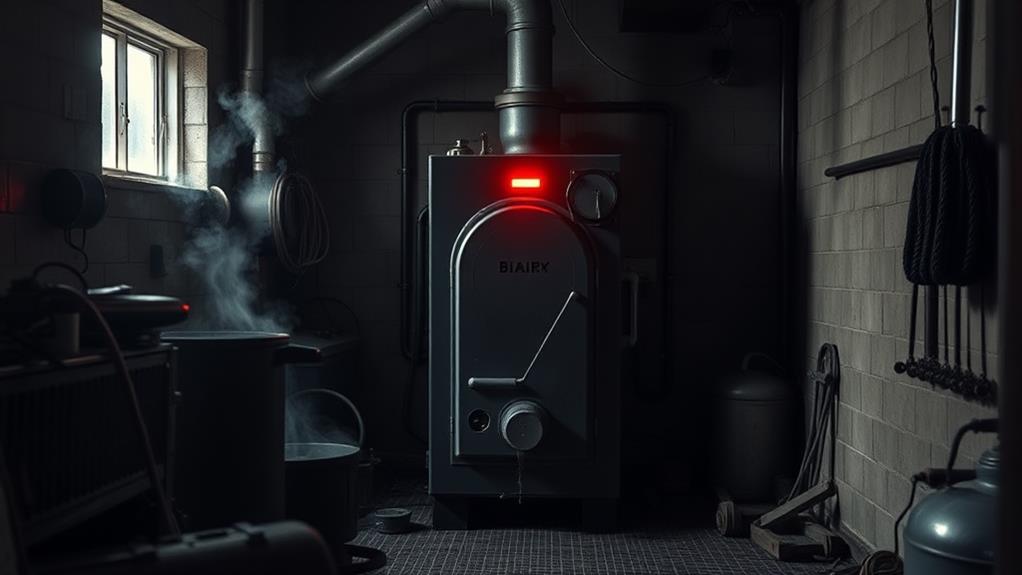
When you encounter the F.28 error code on your boiler, it’s vital to assess the situation carefully and determine if it’s time to call a professional. The F.28 error typically indicates an ignition failure, which can compromise boiler safety if not addressed properly. Start by checking basic elements like gas supply and resetting the boiler. However, if the error persists or if you’re unsure about any step, a professional assessment is significant.
A qualified technician can identify underlying issues that might not be apparent to the untrained eye. They have the expertise to handle complex components safely and efficiently, guaranteeing your boiler operates without risk. Ignition problems could stem from faulty sensors, blocked flues, or gas valve issues—components that require specialized knowledge to evaluate and repair.
Attempting to fix these problems yourself can be hazardous and might invalidate warranties or safety certifications. As a result, calling a professional guarantees that your boiler is not only repaired but also optimized for safe operation. Prioritize boiler safety by relying on expert assessments when persistent F.28 errors arise, protecting both your household and the appliance from further complications.
Preventing Future Boiler Errors
To prevent future boiler errors, you should establish a regular maintenance schedule, ensuring timely inspections and servicing. Upgrading system components, such as thermostats and pressure relief valves, can enhance performance and reliability. By taking these proactive steps, you can minimize the risk of encountering the F.28 error code again.
Regular Maintenance Schedule
Establishing a regular maintenance schedule is vital to preventing future boiler errors like the F.28 error code. By focusing on routine check-ups, you can enhance boiler efficiency and extend its lifespan. Start by creating a detailed maintenance checklist to guarantee nothing gets overlooked. This vigilance minimizes unexpected breakdowns and costly repairs.
Here’s a concise guide to structuring your maintenance routine:
- Inspect and Clean Components: Regularly inspect the heat exchanger, burners, and flue for any signs of wear or blockages. Cleaning these components guarantees ideal combustion and heat transfer.
- Check Pressure Levels: Proper pressure is critical for efficient boiler operation. Verify that the pressure gauge reads within the manufacturer’s recommended range to avoid strain on the system.
- Test Safety Devices: Confirm all safety mechanisms, such as pressure relief valves and thermostats, are functioning correctly. This testing prevents dangerous malfunctions.
- Monitor Fuel Supply: Regularly check for leaks or inconsistencies in fuel delivery. Proper fuel supply maintains consistent boiler performance and prevents error codes like F.28.
Upgrade System Components
Upgrading key system components is a strategic approach to preventing future boiler errors like the F.28 error code. By focusing on system upgrades, you guarantee that each component functions at peak performance and integrates seamlessly with the rest of the boiler system. Start by evaluating the current components for compatibility with newer technologies. Incompatible parts are often the culprits behind persistent errors, as they can disrupt the system’s harmony and efficiency.
When considering upgrades, prioritize components that directly influence the ignition process, such as the ignition electrodes and gas valve. These are essential in avoiding the F.28 error, which typically relates to ignition issues. Confirm that any new parts are not only compatible with your existing setup but also certified by the manufacturer to maintain system integrity.
Maintaining component compatibility is vital for long-term system reliability. Incompatible upgrades could lead to increased wear and tear or even new error codes. Consult with a certified technician to verify that the selected components meet the boiler’s specifications. By investing in targeted system upgrades, you’re not only addressing current issues but also fortifying your boiler against future malfunctions. This proactive approach will enhance performance and extend your boiler’s lifespan.
Frequently Asked Questions
How Does the Weather Affect the Occurrence of F.28 Error Codes?
Temperature fluctuations and humidity levels greatly impact error occurrences. When temperatures drop, boilers may struggle to ignite, causing errors. High humidity can affect electrical components, leading to malfunctions. Guarantee your boiler’s adequately insulated against cold and moisture to prevent these issues. Regular maintenance and monitoring of weather conditions can help you anticipate and mitigate potential problems. Stay proactive to keep your system running efficiently despite changing weather.
Can the F.28 Error Code Be Related to Power Supply Issues?
Imagine power fluctuations like stormy seas for your boiler’s electrical connections. Yes, they can indeed cause issues. You’ll need to guarantee that your power supply is as steady as a lighthouse beacon. When power wavers, it can disrupt the boiler’s performance, leading to error codes. Check your connections thoroughly; loose or faulty wires are often the culprits. By securing them, you’ll keep your boiler running smoothly and reliably.
Are Specific Boiler Models More Prone to the F.28 Error?
When you’re comparing boiler models, you’ll notice that some are more prone to specific error codes due to manufacturer reliability. It’s essential to check reviews and technical specifications to determine if a particular model frequently encounters issues like the F.28 error. Manufacturers with a history of reliability tend to have fewer recurring problems, so choosing a well-reviewed model can minimize your risk of experiencing this error. Always prioritize trusted brands.
Does the Age of the Boiler Influence the Frequency of F.28 Errors?
When considering the boiler’s lifespan, you’ll find that its age can indeed influence the frequency of errors. Older boilers may experience more issues due to worn components. Effective maintenance practices are vital in mitigating these problems. Regular servicing and inspections help guarantee that even older boilers operate efficiently, reducing the likelihood of frequent errors. By prioritizing upkeep, you can extend the boiler’s lifespan and maintain peak performance.
What Are the Costs Associated With Fixing an F.28 Error?
When you encounter error codes, you might wonder about repair costs. Typically, costs vary depending on parts needed and labor. To minimize these expenses, follow maintenance tips like regularly checking connections and cleaning components. Routine inspections by a professional can prevent issues. While repair costs can be significant, proactive maintenance often reduces them, ensuring your system operates efficiently. Addressing problems early on helps you avoid more expensive repairs later.
Summary
So, after maneuvering through the maze of F.28 error codes, you’ve become a pseudo-boiler expert, haven’t you? While juggling ignition issues and gas supply checks might sound like a weekend hobby, remember, boilers aren’t exactly the cuddly companions you hoped for. Ironically, just when you think you’ve mastered DIY troubleshooting, it’s often best to call a professional. Consider this a lesson in humility and prevention—where ensuring warmth ironically requires staying cool-headed.

